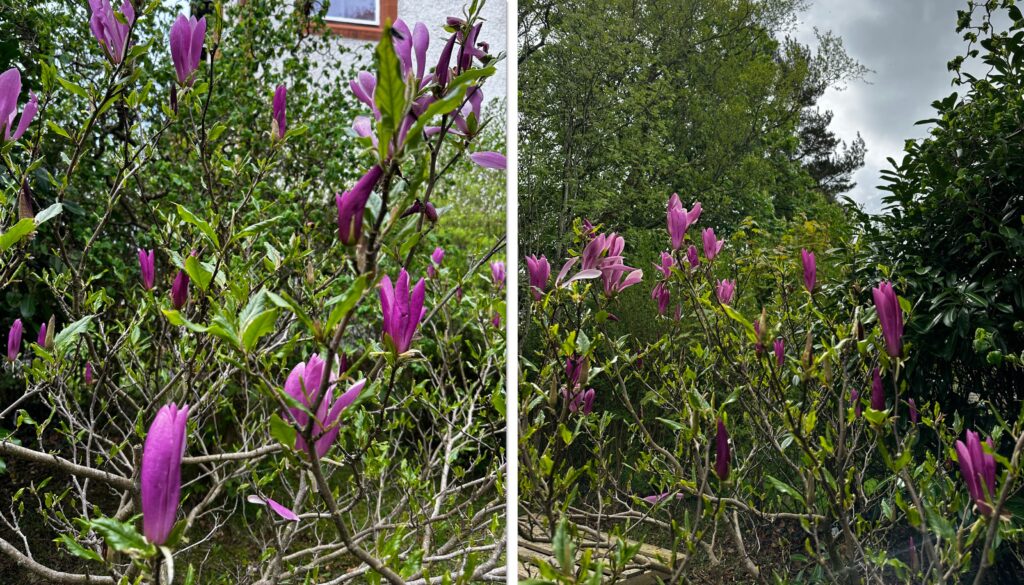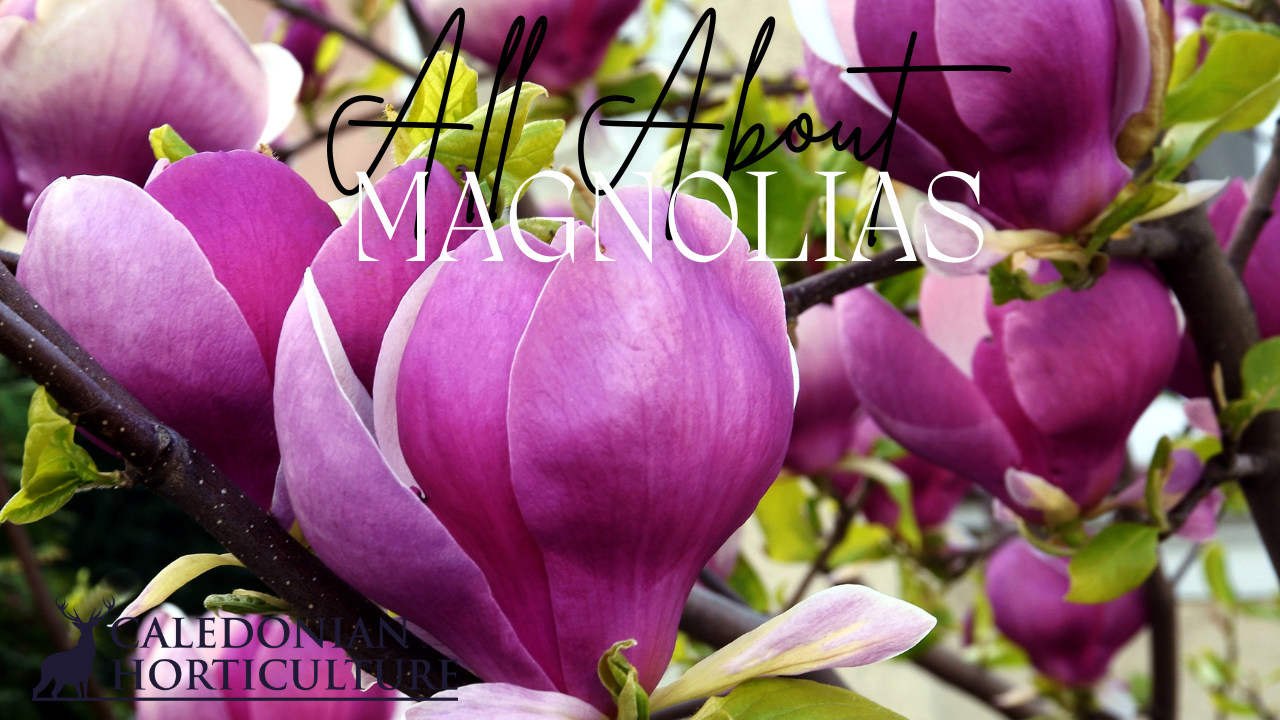Guest post blog by Katrina & Clayton
Magnolia trees are often celebrated for their beautiful spring blossoms, but few people know that many magnolia flowers are an edible gingery flavour perfect for pickles, syrups, salads and unique desserts. Magnolia’s can grow well in Scottish gardens and reward you with both beauty and an unusual culinary ingredient.
The Scottish climate is well suited to magnolias because they appreciate cool, moist conditions and don’t thrive in extreme heat or drought. Spring frosts can damage flower buds, so planting in a sheltered position is key to ensuring consistent flowering. Magnolia stellata (star magnolia) and Magnolia × soulangeana (saucer magnolia) are among the best suited species for Scotland’s temperate climate. We have Magnolia liliiflora ‘Nigra’ Shrub Black Lily Magnolia which also is thriving in the Scottish climate. Once established, magnolias are hardy, long lived plants that bring decades of spring joy.
The edible highlight of magnolia trees is their fragrant petals, which are traditionally pickled in parts of Asia and increasingly used by foraging chefs across Europe. Magnolia petals have a gingery, spicy flavour with a hint of citrus that can elevate both sweet and savoury dishes.
To enjoy them fresh, harvest petals from newly opened flowers and rinse gently to remove any debris. Slice or shred petals to add to salads, fold into cream cheese, or sprinkle over cakes.
Pickling is one of the most popular ways to preserve magnolia petals. Wash and layer petals with salt to draw out moisture, then pack them into jars with rice vinegar, sugar, and aromatics like ginger or chilli. After a week or two, the petals soften and develop a tangy, complex flavour perfect for garnishes.
It’s important to harvest responsibly: only take a few petals per flower or a few full flowers per tree so you don’t disrupt pollination or stress the tree. Also, ensure you’ve correctly identified your magnolia species, as some ornamental varieties may not be palatable or if not your own may have been sprayed with pesticides.

Planting Magnolia Trees
For best results, plant magnolia trees in early Autumn or Spring. These periods offer cool temperatures and ample rainfall to support root establishment before the challenges of Winter or Summer extremes. Choose a location that receives full sun to partial shade, magnolias appreciate morning light but benefit from afternoon shelter in exposed gardens. Wind protection is important, especially for young trees, since strong gales can damage buds and break brittle branches.
Prepare the planting site by digging a hole at least twice as wide as the rootball but no deeper. Loosen the soil at the base to allow roots to spread. Incorporate organic matter like well rotted leaf mould or Caledonian Green Goodness compost to improve structure and water retention, which are crucial in free draining or sandy soils. After planting, water thoroughly and apply a 5–10 cm layer of organic mulch, avoiding contact with the trunk to prevent rot. Mulching helps stabilise soil temperature and moisture, which is especially beneficial in the variable Scottish weather.
Pruning Magnolia Trees
Magnolia trees require minimal pruning, as excessive cutting can spoil their graceful shape and reduce flowering. Instead, aim for light maintenance pruning done shortly after flowering in late Spring or early Summer. This timing gives wounds time to heal before Winter and avoids cutting off next year’s buds, which magnolias set in late Summer.
Remove any dead, diseased, or damaged wood by cutting back to healthy growth. Thin out crowded branches to improve airflow and reduce the risk of fungal diseases in Scotland’s often damp conditions. If you need to control the size or shape of your magnolia, prune selectively and sparingly over a few years rather than drastically in one go. Avoid pruning magnolias in Autumn or Winter since wounds may not heal properly, inviting rot or infection.
Caring for Magnolia Trees
Magnolia trees are low maintenance once established, but young trees benefit from attentive care during the first three to five years. Regular watering is essential in dry spells, Scottish Summers may be wet, but occasional prolonged dry periods can stress magnolias, leading to leaf scorch or reduced flowering.
Mulch annually with compost or bark chips to conserve moisture, regulate soil temperature, and add nutrients as the organic matter breaks down. Keep weeds and grass clear around the base to reduce competition for water and nutrients.

Companion Planting with Magnolia Trees
Magnolias make striking focal points in gardens and are ideal for woodland planting schemes. They work well with companion plants that share their preference for slightly acidic, moisture retentive soils. Underplanting with shade tolerant ground covers not only complements the magnolia’s canopy but also helps retain soil moisture.
Good companions include:
Hostas: with their bold foliage and shade tolerance.
Ferns: which thrive in similar moisture and light conditions.
Bluebells & Snowdrop: which provide an early season carpet of blooms before the magnolia fully leaves out.
Rhododendrons and Azaleas: which flourish in similar soil pH and add more seasonal interest.
Avoid planting aggressive ground covers that can outcompete young magnolia roots. Choose plants that don’t require heavy cultivation around the base of the tree, since magnolias dislike root disturbance.

Growing magnolia trees for edible flowers in Scotland is a great way to combine ornamental beauty with culinary addition. Magnolias bring spectacular early season blooms, provide habitat for pollinators and, with a bit of creativity in the kitchen, offer a unique, gingery treat from your own garden.
Katrina & Clayton

Katrina & Clayton live with their family in East Ayrshire in Scotland and share their daily life in the garden on instagram @buildingfoodforest_scotland. They practice permaculture principles, reducing & repurposing waste whenever they can. Katrina shows how home educating in nature has helped Clayton thrive.
Clayton Completed The Grow and Learn Course with the Royal Caledonian Horticultural Society in 2022. This year he will be completing Level 2 Nurture Course. Clayton is 16, Autistic, Non Verbal & has been Home Educated for the last 6yrs. Both Katrina and husband Peter have studied the Permaculture Design Course PDC and PDC Pro over the last 5yrs, developing their garden from grass to an ongoing food forest.
They have featured on BBC Beechgrove Gardens, Gardeners World Magazine and write for Scotland Grows Magazine. Katrina has a series of children’s story books out following the life of Clayton in the garden. Available at Amazon.
See more and follow Katrina & Clayton at the links below:
-
 Builder’s Bag Planter Mix£79.00 inc VAT
Builder’s Bag Planter Mix£79.00 inc VAT -
 Builder’s Bag Kelpie Compost£72.00 inc VAT
Builder’s Bag Kelpie Compost£72.00 inc VAT -
 Builder’s Bag Green Goodness£52.00 inc VAT
Builder’s Bag Green Goodness£52.00 inc VAT

